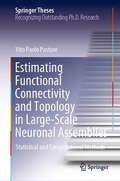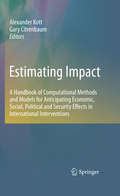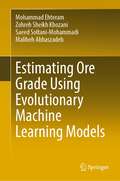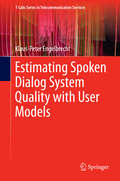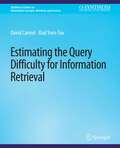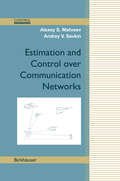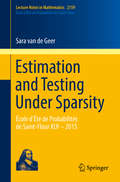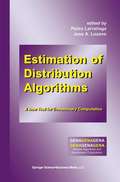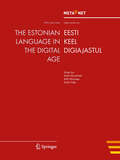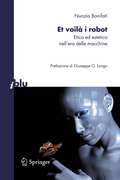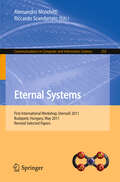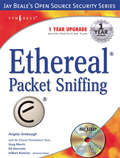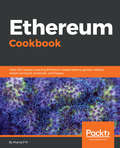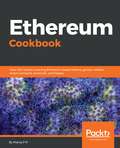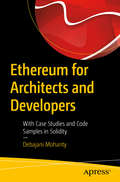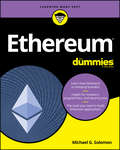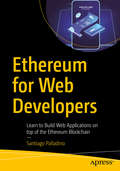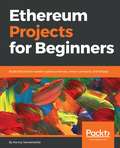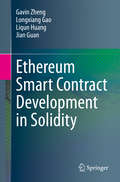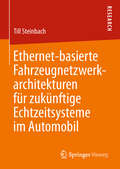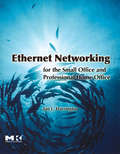- Table View
- List View
Estimating Functional Connectivity and Topology in Large-Scale Neuronal Assemblies: Statistical and Computational Methods (Springer Theses)
by Vito Paolo PastoreThis book describes a set of novel statistical algorithms designed to infer functional connectivity of large-scale neural assemblies. The algorithms are developed with the aim of maximizing computational accuracy and efficiency, while faithfully reconstructing both the inhibitory and excitatory functional links. The book reports on statistical methods to compute the most significant functional connectivity graph, and shows how to use graph theory to extract the topological features of the computed network. A particular feature is that the methods used and extended at the purpose of this work are reported in a fairly completed, yet concise manner, together with the necessary mathematical fundamentals and explanations to understand their application. Furthermore, all these methods have been embedded in the user-friendly open source software named SpiCoDyn, which is also introduced here. All in all, this book provides researchers and graduate students in bioengineering, neurophysiology and computer science, with a set of simplified and reduced models for studying functional connectivity in in silico biological neuronal networks, thus overcoming the complexity of brain circuits.
Estimating Impact: A Handbook of Computational Methods and Models for Anticipating Economic, Social, Political and Security Effects in International Interventions
by Alexander Kott Gary CitrenbaumSociological theories of crime include: theories of strain blame crime on personal stressors; theories of social learning blame crime on its social rewards, and see crime more as an institution in conflict with other institutions rather than as in- vidual deviance; and theories of control look at crime as natural and rewarding, and explore the formation of institutions that control crime. Theorists of corruption generally agree that corruption is an expression of the Patron–Client relationship in which a person with access to resources trades resources with kin and members of the community in exchange for loyalty. Some approaches to modeling crime and corruption do not involve an explicit simulation: rule based systems; Bayesian networks; game theoretic approaches, often based on rational choice theory; and Neoclassical Econometrics, a rational choice-based approach. Simulation-based approaches take into account greater complexities of interacting parts of social phenomena. These include fuzzy cognitive maps and fuzzy rule sets that may incorporate feedback; and agent-based simulation, which can go a step farther by computing new social structures not previously identified in theory. The latter include cognitive agent models, in which agents learn how to perceive their en- ronment and act upon the perceptions of their individual experiences; and reactive agent simulation, which, while less capable than cognitive-agent simulation, is adequate for testing a policy’s effects with existing societal structures. For example, NNL is a cognitive agent model based on the REPAST Simphony toolkit.
Estimating Ore Grade Using Evolutionary Machine Learning Models
by Mohammad Ehteram Zohreh Sheikh Khozani Saeed Soltani-Mohammadi Maliheh AbbaszadehThis book examines the abilities of new machine learning models for predicting ore grade in mining engineering. A variety of case studies are examined in this book. A motivation for preparing this book was the absence of robust models for estimating ore grade. Models of current books can also be used for the different sciences because they have high capabilities for estimating different variables. Mining engineers can use the book to determine the ore grade accurately. This book helps identify mineral-rich regions for exploration and exploitation. Exploration costs can be decreased by using the models in the current book. In this book, the author discusses the new concepts in mining engineering, such as uncertainty in ore grade modeling. Ensemble models are presented in this book to estimate ore grade. In the book, readers learn how to construct advanced machine learning models for estimating ore grade. The authors of this book present advanced and hybrid models used to estimate ore grade instead of the classic methods such as kriging. The current book can be used as a comprehensive handbook for estimating ore grades. Industrial managers and modelers can use the models of the current books. Each level of ore grade modeling is explained in the book. In this book, advanced optimizers are presented to train machine learning models. Therefore, the book can also be used by modelers in other fields. The main motivation of this book is to address previous shortcomings in the modeling process of ore grades. The scope of this book includes mining engineering, soft computing models, and artificial intelligence.
Estimating Spoken Dialog System Quality with User Models (T-Labs Series in Telecommunication Services)
by Klaus-Peter EngelbrechtSpoken dialog systems have the potential to offer highly intuitive user interfaces, as they allow systems to be controlled using natural language. However, the complexity inherent in natural language dialogs means that careful testing of the system must be carried out from the very beginning of the design process. This book examines how user models can be used to support such early evaluations in two ways: by running simulations of dialogs, and by estimating the quality judgments of users. First, a design environment supporting the creation of dialog flows, the simulation of dialogs, and the analysis of the simulated data is proposed. How the quality of user simulations may be quantified with respect to their suitability for both formative and summative evaluation is then discussed. The remainder of the book is dedicated to the problem of predicting quality judgments of users based on interaction data. New modeling approaches are presented, which process the dialogs as sequences, and which allow knowledge about the judgment behavior of users to be incorporated into predictions. All proposed methods are validated with example evaluation studies.
Estimating the Query Difficulty for Information Retrieval (Synthesis Lectures on Information Concepts, Retrieval, and Services)
by David Carmel Elad Yom-TovMany information retrieval (IR) systems suffer from a radical variance in performance when responding to users' queries. Even for systems that succeed very well on average, the quality of results returned for some of the queries is poor. Thus, it is desirable that IR systems will be able to identify "difficult" queries so they can be handled properly. Understanding why some queries are inherently more difficult than others is essential for IR, and a good answer to this important question will help search engines to reduce the variance in performance, hence better servicing their customer needs. Estimating the query difficulty is an attempt to quantify the quality of search results retrieved for a query from a given collection of documents. This book discusses the reasons that cause search engines to fail for some of the queries, and then reviews recent approaches for estimating query difficulty in the IR field. It then describes a common methodology for evaluating the prediction quality of those estimators, and experiments with some of the predictors applied by various IR methods over several TREC benchmarks. Finally, it discusses potential applications that can utilize query difficulty estimators by handling each query individually and selectively, based upon its estimated difficulty. Table of Contents: Introduction - The Robustness Problem of Information Retrieval / Basic Concepts / Query Performance Prediction Methods / Pre-Retrieval Prediction Methods / Post-Retrieval Prediction Methods / Combining Predictors / A General Model for Query Difficulty / Applications of Query Difficulty Estimation / Summary and Conclusions
Estimation and Control over Communication Networks (Control Engineering)
by Alexey S. Matveev Andrey V. SavkinThis book presents a systematic theory of estimation and control over communication networks. It develops a theory that utilizes communications, control, information and dynamical systems theory motivated and applied to advanced networking scenarios. The book establishes theoretically rich and practically important connections among modern control theory, Shannon information theory, and entropy theory of dynamical systems originated in the work of Kolmogorov. This self-contained monograph covers the latest achievements in the area. It contains many real-world applications and the presentation is accessible.
Estimation and Testing Under Sparsity: École d'Été de Probabilités de Saint-Flour XLV – 2015 (Lecture Notes in Mathematics #2159)
by Sara van de GeerTaking the Lasso method as its starting point, this book describes the main ingredients needed to study general loss functions and sparsity-inducing regularizers. It also provides a semi-parametric approach to establishing confidence intervals and tests. Sparsity-inducing methods have proven to be very useful in the analysis of high-dimensional data. Examples include the Lasso and group Lasso methods, and the least squares method with other norm-penalties, such as the nuclear norm. The illustrations provided include generalized linear models, density estimation, matrix completion and sparse principal components. Each chapter ends with a problem section. The book can be used as a textbook for a graduate or PhD course.
Estimation of Distribution Algorithms: A New Tool for Evolutionary Computation (Genetic Algorithms and Evolutionary Computation #2)
by Pedro Larrañaga José A. LozanoEstimation of Distribution Algorithms: A New Tool for Evolutionary Computation is devoted to a new paradigm for evolutionary computation, named estimation of distribution algorithms (EDAs). This new class of algorithms generalizes genetic algorithms by replacing the crossover and mutation operators with learning and sampling from the probability distribution of the best individuals of the population at each iteration of the algorithm. Working in such a way, the relationships between the variables involved in the problem domain are explicitly and effectively captured and exploited. This text constitutes the first compilation and review of the techniques and applications of this new tool for performing evolutionary computation. Estimation of Distribution Algorithms: A New Tool for Evolutionary Computation is clearly divided into three parts. Part I is dedicated to the foundations of EDAs. In this part, after introducing some probabilistic graphical models - Bayesian and Gaussian networks - a review of existing EDA approaches is presented, as well as some new methods based on more flexible probabilistic graphical models. A mathematical modeling of discrete EDAs is also presented. Part II covers several applications of EDAs in some classical optimization problems: the travelling salesman problem, the job scheduling problem, and the knapsack problem. EDAs are also applied to the optimization of some well-known combinatorial and continuous functions. Part III presents the application of EDAs to solve some problems that arise in the machine learning field: feature subset selection, feature weighting in K-NN classifiers, rule induction, partial abductive inference in Bayesian networks, partitional clustering, and the search for optimal weights in artificial neural networks. Estimation of Distribution Algorithms: A New Tool for Evolutionary Computation is a useful and interesting tool for researchers working in the field of evolutionary computation and for engineers who face real-world optimization problems. This book may also be used by graduate students and researchers in computer science. `... I urge those who are interested in EDAs to study this well-crafted book today.' David E. Goldberg, University of Illinois Champaign-Urbana.
The Estonian Language in the Digital Age (White Paper Series)
by Georg Rehm Hans UszkoreitThis white paper is part of a series that promotes knowledge about language technology and its potential. It addresses educators, journalists, politicians, language communities and others. The availability and use of language technology in Europe varies between languages. Consequently, the actions that are required to further support research and development of language technologies also differ for each language. The required actions depend on many factors, such as the complexity of a given language and the size of its community. META-NET, a Network of Excellence funded by the European Commission, has conducted an analysis of current language resources and technologies. This analysis focused on the 23 official European languages as well as other important national and regional languages in Europe. The results of this analysis suggest that there are many significant research gaps for each language. A more detailed expert analysis and assessment of the current situation will help maximise the impact of additional research and minimize any risks. META-NET consists of 54 research centres from 33 countries that are working with stakeholders from commercial businesses, government agencies, industry, research organisations, software companies, technology providers and European universities. Together, they are creating a common technology vision while developing a strategic research agenda that shows how language technology applications can address any research gaps by 2020.
Et al.: Because not all research deserves a Nobel Prize
by B McGrawEt al. is a satirical academic journal that uses machine learning and scientific principles on absurd studies, from the cat Lord Whiskers' role in the extinction of the dodo bird to the quantum mysteries of untidy toddler rooms.Key FeaturesConducts satirical research on topics ranging from quantum computing to clingy robot dog algorithmsAnswers questions like “Can a computer understand a Scotsman?” and “Is Sarah Palin real?”Secures the power grid and your home from the prying eyes of government drones a.k.a. birdsExpands science by studying cow-based atmospheres, and the flavortown center of the brainSolves climate change and saves the world by proposing a banana-based fission reactorNullifies the possibility of getting lost at the fair with a mirror-house escape algorithmBook DescriptionTired of the same old math, science, statistics, and programming memes people post online and want something a little more elaborate? This is the book for you. Tremble as we make up all our own facts and data, hand-draw diagrams in MS Paint, and quote from fictional studies and journals. Cower as authors write in the first person because their study is just a little too personal for them. Recoil from the sheer mass of oversimplified methodology, distilling someone's entire thesis into a paragraph of jokes crude enough to make it into a Mike Myers movie. Over the last few years, we have taken arguments that you would normally have after four Jack and cokes at game night and turned them into properly formatted research papers with a writing tone serious enough to confuse the uninitiated. These papers are high-effort jokes by researchers and scientists for researchers and scientists. They cover a range of topics such as the consequences of re-releasing tourists back into Yellowstone National Park after COVID-19, how to play StarCraft competitively online on a quantum computer, and most importantly, how trees around the globe are becoming increasingly radicalized.What you will learnHow to draw a graph using MS Paint, maybeWhether Sarah Palin is a figment of your imaginationHow one pirate cat brought about the extinction of the beloved dodoWhy rabbits used to be jerks back in the dayIf you actually learn anything from these articles, get your memory erased immediatelyWho this book is forThis book is for researchers and those who love science mingled with humor. It's for those who are a little too tired of the talking heads and futurists of the science world and would like something more entertaining in the form of absurd speculative studies by researchers as unbelievable as their work. Anyone who has experienced academic writing, or the tribulations of any research institution will enjoy the wide range of bizarre, yet real-world topics compiled in this book. Even if you don't know much about the subject, we usually have a background section.
Et voilà i robot: Etica ed estetica nell'era delle macchine (I blu)
by Nunzia BonifatiI robot. Ci somigliano e come noi sanno imparare dall’esperienza, decidere in modo autonomo, muoversi in libertà, comunicare con il linguaggio e con la mimica. Presto li useremo come estensioni del nostro corpo, per migliorarci e renderci più sani e forti. E forse, domani, saranno simili agli organismi viventi. Dal Golem a Terminator, è dalla notte dei tempi che l’umanità sogna queste creature immortalandole in figure di eroi salvifici o di mostri temibili nel mito, nella letteratura, nel cinema. E oggi questi figli dell’immaginazione e della conoscenza, questi simboli del legame inscindibile tra uomo e tecnologia approdano dal regno della fantasia alla realtà quotidiana, inaugurando quella che per gli esperti sarà l’era dei robot. Siamo pronti al loro debutto in società? Riusciremo a convivere con queste macchine senza divenirne schiavi? Sapremo farne un uso pacifico, per il bene dell’umanità e dei robot stessi?
Eternal Systems: First International Workshop, EternalS 2011, Budapest, Hungary, May 3, 2011, Revised Selected Papers (Communications in Computer and Information Science #255)
by Alessandro Moschitti Riccardo ScandariatoThis book constitutes the refereed post-proceedings of the First International Workshop on Eternal Systems, EternalS 2011, held in Budapest, Hungary, in May 2011. The workshop aimed at creating the conditions for mutual awareness and cross-fertilization among broad ICT areas such as learning systems for knowledge management and representation, software systems, networked systems and secure systems, by focusing on their shared objectives such as adaptation, evolvability and flexibility for the development of long living and versatile systems. The 6 revised full papers and 4 short papers presented were carefully reviewed and selected from 15 submissions. They are organized in topical sections on software and secure systems, machine learning for software systems, and ontology and knowledge representations.
Ethereal Packet Sniffing
by SyngressThis book provides system administrators with all of the information as well as software they need to run Ethereal Protocol Analyzer on their networks. There are currently no other books published on Ethereal, so this book will begin with chapters covering the installation and configuration of Ethereal. From there the book quickly moves into more advanced topics such as optimizing Ethereal's performance and analyzing data output by Ethereal. Ethereal is an extremely powerful and complex product, capable of analyzing over 350 different network protocols. As such, this book also provides readers with an overview of the most common network protocols used, as well as analysis of Ethereal reports on the various protocols. The last part of the book provides readers with advanced information on using reports generated by Ethereal to both fix security holes and optimize network performance.Provides insider information on how to optimize performance of Ethereal on enterprise networks.Book comes with a CD containing Ethereal, Tethereal, Nessus, Snort, ACID, Barnyard, and more!Includes coverage of popular command-line version, Tethereal.
Ethereum Cookbook: Over 100 recipes covering Ethereum-based tokens, games, wallets, smart contracts, protocols, and Dapps
by Manoj P RMine Ether, deploy smart contracts, tokens, and ICOs, and manage security vulnerabilities of Ethereum Key Features Build end-to-end decentralized Ethereum apps using Truffle, Web3, and Solidity Explore various solution-based recipes to build smart contracts and foolproof decentralized applications Develop decentralized marketplaces from scratch, build wallets, and manage transactions Book Description Ethereum and Blockchain will change the way software is built for business transactions. Most industries have been looking to leverage these new technologies to gain efficiencies and create new business models and opportunities. The Ethereum Cookbook covers various solutions such as setting up Ethereum, writing smart contracts, and creating tokens, among others. You'll learn about the security vulnerabilities, along with other protocols of Ethereum. Once you have understood the basics, you'll move on to exploring various design decisions and tips to make your application scalable and secure. In addition to this, you'll work with various Ethereum packages such as Truffle, Web3, and Ganache. By the end of this book, you'll have comprehensively grasped the Ethereum principles and ecosystem. What you will learn Efficiently write smart contracts in Ethereum Build scalable distributed applications and deploy them Use tools and frameworks to develop, deploy, and test your application Use block explorers such as Etherscan to find a specific transaction Create your own tokens, initial coin offerings (ICOs), and games Understand various security flaws in smart contracts in order to avoid them Who this book is for The Ethereum Cookbook is for you if you are a software engineer, Blockchain developer, or research scientist who wants to build smart contracts, develop decentralized applications, and facilitate peer-to-peer transaction. It is assumed that you are familiar with Blockchain concepts and have sound knowledge of JavaScript.
Ethereum Cookbook: Over 100 recipes covering Ethereum-based tokens, games, wallets, smart contracts, protocols, and Dapps
by Manoj P RMine Ether, deploy smart contracts, tokens, and ICOs, and manage security vulnerabilities of Ethereum Key Features Build end-to-end decentralized Ethereum apps using Truffle, Web3, and Solidity Explore various solution-based recipes to build smart contracts and foolproof decentralized applications Develop decentralized marketplaces from scratch, build wallets, and manage transactions Book Description Ethereum and Blockchain will change the way software is built for business transactions. Most industries have been looking to leverage these new technologies to gain efficiencies and create new business models and opportunities. The Ethereum Cookbook covers various solutions such as setting up Ethereum, writing smart contracts, and creating tokens, among others. You'll learn about the security vulnerabilities, along with other protocols of Ethereum. Once you have understood the basics, you'll move on to exploring various design decisions and tips to make your application scalable and secure. In addition to this, you'll work with various Ethereum packages such as Truffle, Web3, and Ganache. By the end of this book, you'll have comprehensively grasped the Ethereum principles and ecosystem. What you will learn Efficiently write smart contracts in Ethereum Build scalable distributed applications and deploy them Use tools and frameworks to develop, deploy, and test your application Use block explorers such as Etherscan to find a specific transaction Create your own tokens, initial coin offerings (ICOs), and games Understand various security flaws in smart contracts in order to avoid them Who this book is for The Ethereum Cookbook is for you if you are a software engineer, Blockchain developer, or research scientist who wants to build smart contracts, develop decentralized applications, and facilitate peer-to-peer transaction. It is assumed that you are familiar with Blockchain concepts and have sound knowledge of JavaScript.
Ethereum Cookbook: Over 100 Recipes Covering Ethereum-based Tokens, Games, Wallets, Smart Contracts, Protocols, And Dapps
by Manoj P REthereum is an open-source, public, Blockchain-based distributed computing platform and operating system featuring smart contract functionality which builds decentralized applications. If you want to get started with Ethereum and Solidity or you are among the many developers already working with this platform, this book is your one-stop guide.
Ethereum for Architects and Developers: With Case Studies And Code Samples In Solidity
by Debajani MohantyExplore the Ethereum ecosystem step by step with extensive theory, labs, and live use cases. This book takes you through BlockChain concepts; decentralized applications; Ethereum’s architecture; Solidity smart contract programming with examples; and testing, debugging, and deploying smart contracts on your local machine and on the cloud. You’ll cover best practices for writing contracts with ample examples to allow you to write high-quality contracts with optimal usage of fuel. In later chapters, Ethereum for Architects and Developers covers use cases from different business areas, such as finance, travel, supply-chain, insurance, and land registry. Many of these sectors are explained with flowcharts, diagrams, and sample code that you can refer to and further enhance in live projects.By the end of the book, you will have enough information to use Ethereum to create value for your business processes and build foolproof data storage for smoother execution of business.What You Will Learn Discover key BlockChain conceptsMaster the architecture, building blocks, and ecosystem of EthereumDevelop smart contracts from scratch Debug, test, and deploy to test Take advantage of Ethereum in your business area Who This Book Is ForBlockChain developers and architects wanting to develop decentralized Ethereum applications or learn its architecture.
Ethereum For Dummies
by Michael G. SolomonDive into a secure future Professionals look to Ethereum as a blockchain-based platform to develop safe applications and conduct secure transactions. It takes a knowledgeable guiding hand to understand how Ethereum works and what it does — and Ethereum For Dummies provides that guidance. Written by one of the leading voices in the blockchain community and best selling author of Blockchain For Dummies, this book demystifies the workings of Ethereum and shows how it can enhance security, transactions, and investments. As an emerging application of blockchain technology, Ethereum attracts a wide swath of professionals ranging from financial pros who see it as a way to enhance their business, security analysts who want to conduct secure transactions, programmers who build apps that employ the Ethereum blockchain, or investors interested in cashing in on the rise of cryptocurrency. Ethereum For Dummies offers a starting point to all members of this audience as it provides easy-to-understand explanation of the tools and techniques of using Ethereum. Understand the fundamentals of Ethereum Build smart contracts Create decentralized applications Examine public and private chains If you need to get a grip on one of the biggest applications of blockchain technology, this book makes it easier.
Ethereum For Dummies
by Michael G. SolomonDive into a secure future Professionals look to Ethereum as a blockchain-based platform to develop safe applications and conduct secure transactions. It takes a knowledgeable guiding hand to understand how Ethereum works and what it does — and Ethereum For Dummies provides that guidance. Written by one of the leading voices in the blockchain community and best selling author of Blockchain For Dummies, this book demystifies the workings of Ethereum and shows how it can enhance security, transactions, and investments. As an emerging application of blockchain technology, Ethereum attracts a wide swath of professionals ranging from financial pros who see it as a way to enhance their business, security analysts who want to conduct secure transactions, programmers who build apps that employ the Ethereum blockchain, or investors interested in cashing in on the rise of cryptocurrency. Ethereum For Dummies offers a starting point to all members of this audience as it provides easy-to-understand explanation of the tools and techniques of using Ethereum. Understand the fundamentals of Ethereum Build smart contracts Create decentralized applications Examine public and private chains If you need to get a grip on one of the biggest applications of blockchain technology, this book makes it easier.
Ethereum for Web Developers: Learn to Build Web Applications on top of the Ethereum Blockchain
by Santiago PalladinoTechnology is constantly evolving, and blockchain is taking development to new places, as mobile did a decade ago – and Ethereum is the leading platform for creating this new wave of applications. This book reveals everything you need to create a robust decentralized application (more commonly known as DApp). Unlike other books on the topic, this one focuses on the web application layer, and guides you in creating great experiences on top of the Ethereum blockchain. You’ll review the challenges and differences involved in developing DApps as opposed to traditional web applications. After a brief introduction to blockchain history and Ethereum in particular, you’ll jump directly into building a sample decentralized application, to familiarize yourself with all the moving pieces. This book offers specific chapters on querying and rendering data from the blockchain, reacting to events, interacting with user accounts, sending transactions, managing gas, handling confirmations and reorganizations, and more. You will also find a chapter dedicated to Solidity that will give you the necessary means to understand and even build your own smart contracts. Other important topics covered include building backend servers that act as indexing layers, and managing storage efficiently with solutions like the interplanetary file system, or IPFS. Last but not least, you will find chapters that examine the biggest problems on Ethereum today: onboarding and scalability. These include the state of the art of the available strategies to tackle them, such as meta-transactions, smart accounts, ENS, state channels, sidechains, and more. What You'll Learn Connect to the blockchain from the browser and send transactions from client-sideBuild a web app that provides a read-only interface to a blockchain contract Create a wallet interface for arbitrary fungible tokens, displaying the user’s balance and allowing for simple transfers to other addressesDevelop a web app that stores large blobs of data off-chain, and keeps a reference to it on-chain (e.g. avatars, long text descriptions) Produce a web app that relies on a centralized server for indexing on-chain information to be presented to the user Who This Book Is ForWeb developers focused on client-side applications, with knowledge of JavaScript and HTML/CSS. You do not need any prior knowledge of Blockchain, Ethereum, or cryptocurrency.
Ethereum Projects for Beginners: Build blockchain-based cryptocurrencies, smart contracts, and DApps
by Kenny VaneetveldeUnderstand the Ethereum platform to build distributed applications that are secured and decentralized using blockchain technology Key Features Build your own decentralized applications using real-world blockchain examples Implement Ethereum for building smart contracts and cryptocurrency applications with easy-to-follow projects Enhance your application security with blockchain Book Description Ethereum enables the development of efficient, smart contracts that contain code. These smart contracts can interact with other smart contracts to make decisions, store data, and send Ether to others.Ethereum Projects for Beginners provides you with a clear introduction to creating cryptocurrencies, smart contracts, and decentralized applications. As you make your way through the book, you'll get to grips with detailed step-by-step processes to build advanced Ethereum projects. Each project will teach you enough about Ethereum to be productive right away. You will learn how tokenization works, think in a decentralized way, and build blockchain-based distributed computing systems. Towards the end of the book, you will develop interesting Ethereum projects such as creating wallets and secure data sharing.By the end of this book, you will be able to tackle blockchain challenges by implementing end-to-end projects using the full power of the Ethereum blockchain. What you will learn Develop your ideas fast and efficiently using the Ethereum blockchain Make writing and deploying smart contracts easy and manageable Work with private data in blockchain applications Handle large files in blockchain applications Ensure your decentralized applications are safe Explore how Ethereum development frameworks work Create your own cryptocurrency or token on the Ethereum blockchain Make sure your cryptocurrency is ERC20-compliant to launch an ICO Who this book is for This book is for individuals who want to build decentralized applications using blockchain technology and the power of Ethereum from scratch. Some prior knowledge of JavaScript is required, since most examples use a web frontend.
Ethereum Projects for Beginners: Build blockchain-based cryptocurrencies, smart contracts, and DApps
by Kenny VaneetveldeUnderstand the Ethereum platform to build distributed applications that are secured and decentralized using blockchain technology Key Features Build your own decentralized applications using real-world blockchain examples Implement Ethereum for building smart contracts and cryptocurrency applications with easy-to-follow projects Enhance your application security with blockchain Book Description Ethereum enables the development of efficient, smart contracts that contain code. These smart contracts can interact with other smart contracts to make decisions, store data, and send Ether to others.Ethereum Projects for Beginners provides you with a clear introduction to creating cryptocurrencies, smart contracts, and decentralized applications. As you make your way through the book, you'll get to grips with detailed step-by-step processes to build advanced Ethereum projects. Each project will teach you enough about Ethereum to be productive right away. You will learn how tokenization works, think in a decentralized way, and build blockchain-based distributed computing systems. Towards the end of the book, you will develop interesting Ethereum projects such as creating wallets and secure data sharing.By the end of this book, you will be able to tackle blockchain challenges by implementing end-to-end projects using the full power of the Ethereum blockchain. What you will learn Develop your ideas fast and efficiently using the Ethereum blockchain Make writing and deploying smart contracts easy and manageable Work with private data in blockchain applications Handle large files in blockchain applications Ensure your decentralized applications are safe Explore how Ethereum development frameworks work Create your own cryptocurrency or token on the Ethereum blockchain Make sure your cryptocurrency is ERC20-compliant to launch an ICO Who this book is for This book is for individuals who want to build decentralized applications using blockchain technology and the power of Ethereum from scratch. Some prior knowledge of JavaScript is required, since most examples use a web frontend.
Ethereum Smart Contract Development in Solidity
by Gavin Zheng Longxiang Gao Liqun Huang Jian GuanThe general consensus is that BlockChain is the next disruptive technology, and Ethereum is the flagship product of BlockChain 2.0. However, coding and implementing business logic in a decentralized and transparent environment is fundamentally different from traditional programming and is emerging as a major challenge for developers.This book introduces readers to the Solidity language from scratch, together with case studies and examples. It also covers advanced topics and explains the working mechanism of smart contracts in depth. Further, it includes relevant examples that shed new light on the forefront of Solidity programming. In short, it equips readers with essential practical skills, allowing them to quickly catch up and start using Solidity programming.To gain the most from the book, readers should have already learned at least one object-oriented programming language
Ethernet-basierte Fahrzeugnetzwerkarchitekturen für zukünftige Echtzeitsysteme im Automobil
by Till SteinbachTill Steinbach leistet einen Beitrag zum Design und zur Bewertung neuer Ethernet-basierter Fahrzeugnetzwerkarchitekturen. Er liefert Werkzeuge für die simulationsbasierte Analyse und Beurteilung von Netzwerkarchitekturen und evaluiert anhand konkreter Anwendungen und auf echten Verkehrsdaten aufbauender Szenarien mögliche Netzwerkdesigns und Konfigurationen. Dabei berücksichtigt der Autor auch den Übergang von Legacy-Technologien hin zu einem rein Echtzeit-Ethernet-basierten Fahrzeugnetzwerk. Auf Basis der aus analytischen Modellen sowie Simulationsstudien und einem realen Fahrzeugprototyp gewonnenen Erkenntnisse spricht er Designempfehlungen für die Entwicklung zukünftiger Ethernet-basierter Fahrzeugnetzwerke aus. Die Ergebnisse der Untersuchung führen zu Best Practices für zukünftige Backbone-Netzwerke im Automobil, in denen sich die erreichbaren Kennzahlen unter Einhaltung der Designempfehlungen um ein Vielfaches verbessern lassen.Der Autor Till Steinbach ist Teamleiter für Software Integration und Echtzeitsysteme bei einem mittelständischen Automobilzulieferer in Hamburg. Zuvor war er Doktorand in einer Kooperation der Carl von Ossietzky Universität Oldenburg und der HAW Hamburg. 2011 wurde er mit dem Hermann-Appel-Preis ausgezeichnet.
Ethernet Networking for the Small Office and Professional Home Office
by Jan L. HarringtonIn a local area network (LAN) or intranet, there are many pieces of hardare trying to gain access to the network transmission media at the same time (i.e., phone lines, coax, wireless, etc.). However, a network cable or wireless transmission frequency can physically only allow one node to use it at a given time. Therefore, there must be some way to regulate which node has control of the medium (a media access control, or MAC, protocol). Ethernet is a MAC protocol; it is one way to regulate physical access to network tranmission media. Ethernet networking is used primarily by networks that are contained within a single physical location. If you need to design, install, and manage a network in such an envronment, i.e., home or small business office, then Ethernet Networking for the Small Office and Professional Home Office will give you an in-depth understanding of the technology involved in an Ethernet network. One of the major goals of this book is to demystify the jargon of networks so that the reader gains a working familiarity with common networking terminology and acronyms. In addition, this books explains not only how to choose and configure network hardware but also provides practical information about the types of network devices and software needed to make it all work. Tips and direction on how to manage an Ethernet network are also provided. This book therefore goes beyond the hardware aspects of Ethernet to look at the entire network from bottom to top, along with enough technical detail to enable the reader to make intelligent choices about what types of transmission media are used and the way in which the various parts of the network are interconnected.Explains how the Ethernet works, with emphasis on current technologies and emerging trends in gigabit and fast Ethernet, WiFi, routers, and security issuesTeaches how to design and select complementary components of Ethernet networks with a focus on home and small business applicationsDiscuses the various types of cables, software, and hardware involved in constructing, connecting, operating and monitoring Ethernet networks
